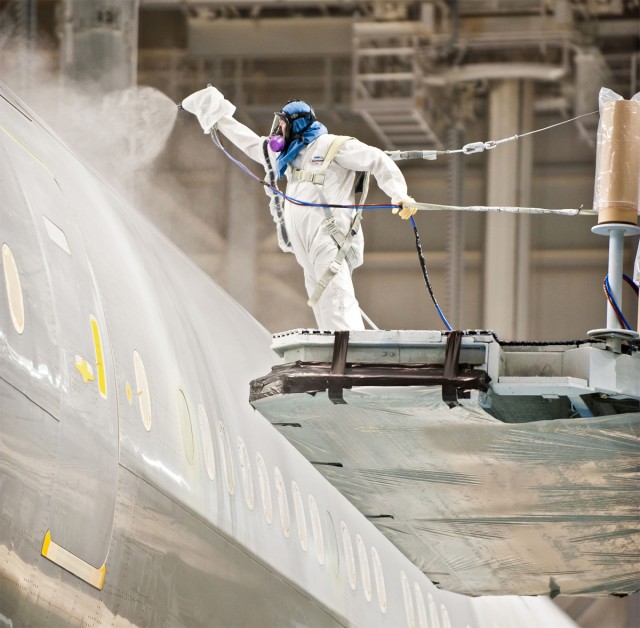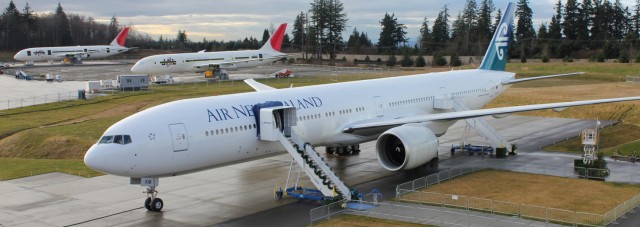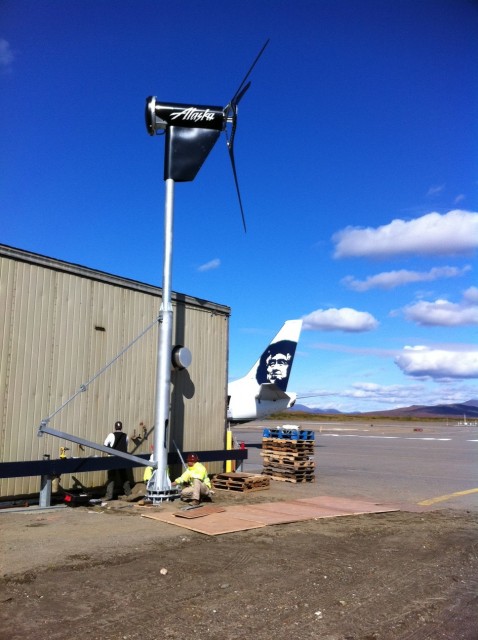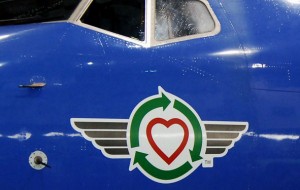
Boeing painter Bill Pearson applies chrome-free primer to the 777-300ER that was delivered to Air New Zealand in November 2011. Photo from Boeing.
Boeing has announced 10 initiatives on the 777 program that will help to eliminate 5.5 million pounds of CO2 and 300,000 gallons of jet fuel per year just in the 777 delivery process.
A lot of attention is given to how airlines can save money and the environment when flying them, but how about aircraft manufactures saving a little green (money and environment) before an aircraft is even delivered?
Before each 777 is delivered, there is a 20-day process of paint, tests and flights before Boeing hands over a brand plane to a customer. Boeing has been working on creating a more efficient process with Air New Zealand, which took delivery of a 777 using all ten initiatives.
“A team of employees identified redundancies in testing,” said Jeff Klemann, vice president Everett Delivery Center stated in a press release. “One idea was to eliminate engine-run tests already performed by GE, the 777’s engine manufacturer. This will result in a reduction of 1.4 million pounds of CO2 in 2012 as well as less community noise and emissions.”

In December 2010, Air New Zealand took delivery of their first Boeing 777-300ER. Photo by AirlineReporter.com.
A team of employees identified redundancies in testing and new more sustainable processes.Through out the 777 delivery process the team implemented the following 10 initiatives:
* Eliminated redundant fuel test in pre-delivery flight test
* Reduced the amount of times hydraulic filters are changed
* Eliminated engine-run tests already performed by GE
* Used waste fuel carts
* Reduced the number of times potable water is changed
* Reduced the amount of times engine fuel filters are changed
* Enhanced recycling throughout the delivery process
* Used electric carts instead of gas-powered vehicles
* Improved flight planning efficiency for pre-delivery flights to reduce fuel loads and flight times
* Used chrome-free primer
Nine of the initiatives will come standard with all future 777 deliveries. Usage of the special chrome-free paint will be an airline option.
MORE AIR NEW ZEALAND 777 STUFF:
* Behind the scenes of an ANZ 777-300ER delivery
* Checking out the interior of ANZ’s 777-300ER

Wind power for Alaska Airlines up in Nome, Alaska. Photo from Alaska Airlines.
So where the heck is Nome, Alaska? It is pretty darn as close to the middle of no where as you can get, although it is on the western edge of Alaska. It is a small town of less than 4,000 people and transportation to destinations outside the city is difficult to come by. Roads connect Nome to smaller cities up to 54 miles away, but there are no roads connecting the city to the rest of the world. For the town to operate, it requires transportation via water and air.
Air travel becomes a necessity to get goods and people to and from remote areas in Alaska and Alaska Airlines is one of a few airlines operating out of Nome ’“ it is also the largest.
Nome has long days in the summer, short in the winter and is the end destination of the Iditarod dog sled race. The remote city is also known for its fierce winds of 80 to 90mph. With being so remote, having strong winds and long days of light in the summer, it makes sense for locals to look at alternative sources of energy and that is just what Alaska Airlines has done.
Recently the airline built a 30-foot wind turbine next to the Nome Terminal and installed solar panel array on the roof. According to Alaska, ’œthe project is the first foray for Alaska Airlines into using wind and solar power to produce a significant amount of an airport’s electricity ’“ and it appears to be the first time a domestic carrier has pursued alternative energy for an airport operation.’
Alaska is hoping that the turbine and solar panels will produce around 15,000 kilowatt hours of power per year, which is about 6 percent of the terminal’s load. If successful, the concept may be expanded to other rural airports in Alaska, said Ron Suttell, Alaska’s director of facilities planning and administration.
“The turbine was selected because it performs well in turbulent air, it is engineered to continue producing electricity in harsh climates and high winds, and the design eliminates icing issues on the blades,” Chris Andree, Alaska Airlines’ regional manager of properties and facilities, who oversaw the project for the airline.

Southwest Airline's green logo
No, Southwest isn’t re-painting their exteriors green, but they are going green with their interiors. The airline is testing a Boeing 737-700 with innovative ideas to reduce weight and to use recycled material.
To start, there are new seats that are about 5lbs lights than their predecessors. This cuts down weight, which cuts down on fuel, which reduces the aircraft’s carbon footprint. It also has carpet that is made of 100% recycled materials and can be replaced in sections, instead of needing to replace the whole aircraft’s carpet, reducing waste.
Materials are not the only change. The aircraft is also kicking off Southwest’s new recycling program, where more items used on the plane will be recycled.
More and more airlines are going green, which is a good thing. However others are trying to reduce weight, to cut costs, to increase profit. Then they say they are doing it to cut down on carbon emissions and as a bonus they can say they are saving the environment. However, Southwest is going a step further, saying this goes past the testing phase and goes fleet-wide.
I talked to Marilee Mcinis, who does Public Relations for Southwest and she stated, “The usage results and customer feedback will help us make a decision on how best to move forward with these materials. We are testing for durability, comfort, etc., so we want to make sure we pick the best product available to meet all of our standards. This is a true test, so we don’t have a particular end date in mind.”
follow us via | web | twitter | email | rss |
Source & Image: InteriorDesign.net

Test Pilot Captain Keith Pattie, right, Air New Zealand's Chief Pilot Captain David Morgan, left, pose with the company's CEO , Rob Fyfe before their test of a Bio Fuel mixture in the left hand engine of Boeing 747 in Auckland, New Zealand
Back in late 2008 I talked about how Boeing was working with Continental Airlines on an algae-based bio fuel.
On Thursday Bill Blover, managing director of environmental strategy for Boeing Commercial Planes stated the new fuel could be approved and in commercial flights as early as early 2010. He states the technology is ready, but there isn’t enough plant stock yet to create enough fuel.
The New York Times reportsthat Boeing has been working with four airlines on four different fuel mixtures, “Virgin Atlantic flight using a coconut- and babassu-derived biofuel blend; an Air New Zealand flight using a jatropha-derived biofuel blend; a Continental Airlines flight using a blend of algae- and jatropha-derived biofuel; and a Japan Airlines flight using an algae-, jatropha- and camelina-derived biofuel blend.”
Air New Zealand showed a 1% improvement in fuel efficiency which might not sound like a lot, but a large jet burning fuel on a 12 hour flight, equates to about a savings of 1.43 metric tons of fuel and 4.5 metric tons of reduced carbon dioxide. Multiply that by the amount of flights going on globally on any given day, and that ads up to a lot of savings.
Even though we might start seeing some new biofuel in some jets starting in early 2010, they will still have to fight production ability and being cost effective compared to jet fuel and if the economy is down, it is most likely airlines won’t be willing to pay a premium for green fuel.
Image: AP Photo/NZ Herald, Paul Estcourt




